National Australia Bank: Information Systems Strategy Report
VerifiedAdded on 2023/02/01
|16
|4307
|65
Report
AI Summary
This report provides an in-depth analysis of the information systems (IS) strategy of the National Australia Bank (NAB). It begins with an introduction to NAB, highlighting its position in the financial sector and the growing importance of IS. The report then delves into NAB's focus on IT product selection, particularly its move towards cloud-based services and a service-centric model. It examines the evolution of NAB's IS/IT strategy, including its AU$1.5 billion investment in digital transformation and the adoption of microservices. The major challenges faced by the business, such as network outages and application glitches, are discussed, along with the role of IS/IT in addressing these issues. The report explores the management of IS, including the implementation of a Salesforce CRM platform. Finally, it covers the execution of the IS/IT strategy, emphasizing the shift to cloud-based services and the transformation of legacy data centers. The report concludes with recommendations for NAB's future IS strategy.
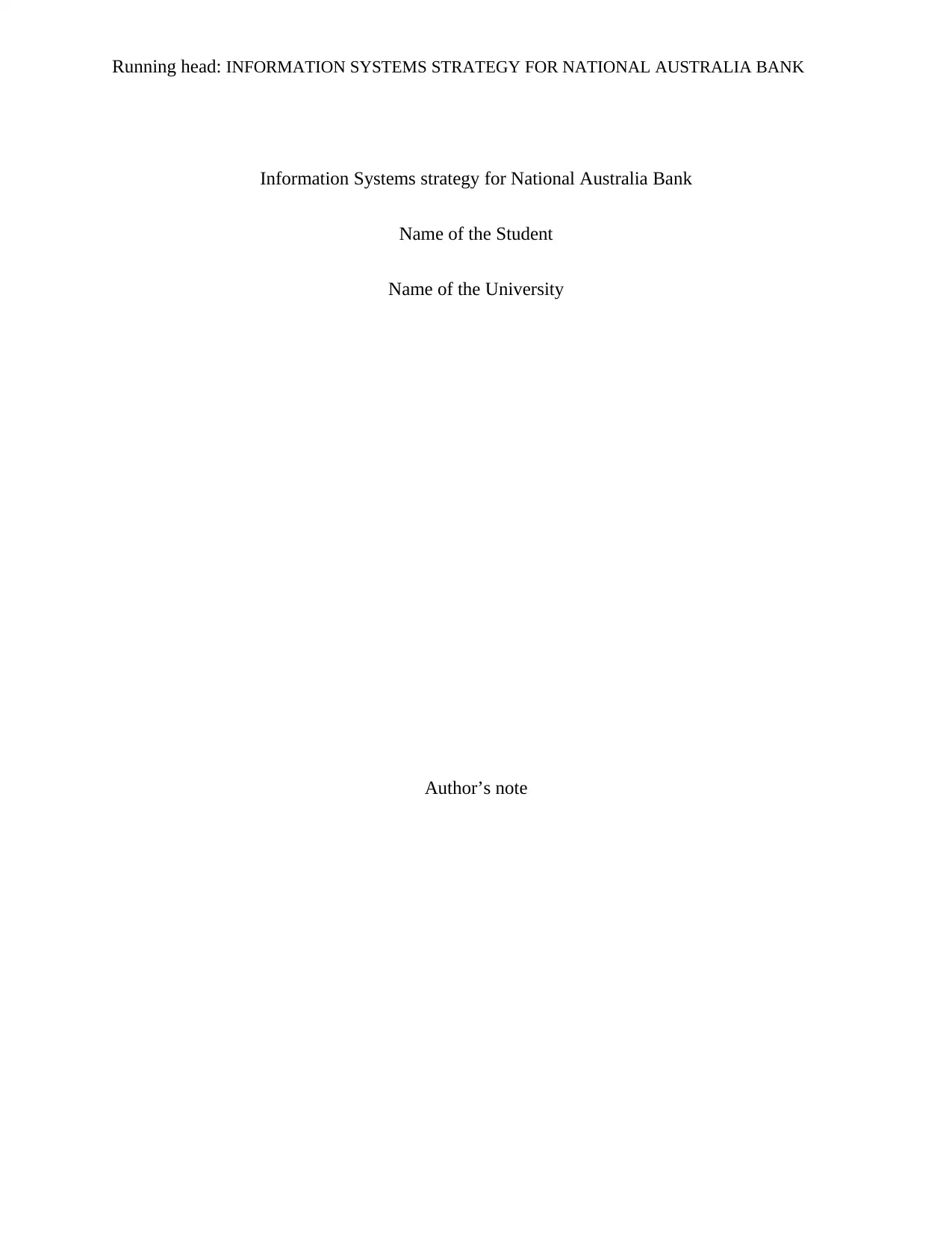
Running head: INFORMATION SYSTEMS STRATEGY FOR NATIONAL AUSTRALIA BANK
Information Systems strategy for National Australia Bank
Name of the Student
Name of the University
Author’s note
Information Systems strategy for National Australia Bank
Name of the Student
Name of the University
Author’s note
Paraphrase This Document
Need a fresh take? Get an instant paraphrase of this document with our AI Paraphraser
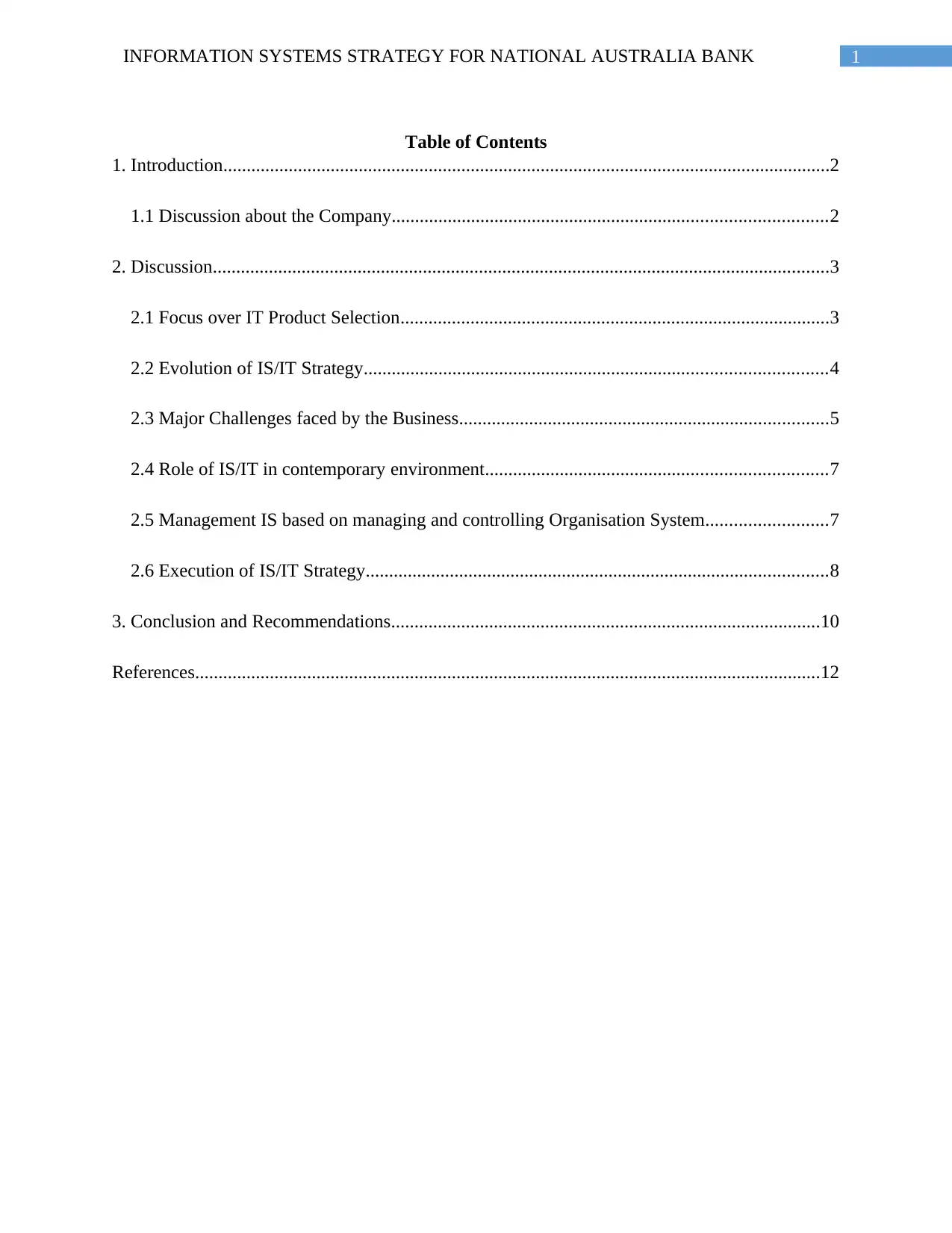
1INFORMATION SYSTEMS STRATEGY FOR NATIONAL AUSTRALIA BANK
Table of Contents
1. Introduction..................................................................................................................................2
1.1 Discussion about the Company.............................................................................................2
2. Discussion....................................................................................................................................3
2.1 Focus over IT Product Selection............................................................................................3
2.2 Evolution of IS/IT Strategy...................................................................................................4
2.3 Major Challenges faced by the Business...............................................................................5
2.4 Role of IS/IT in contemporary environment.........................................................................7
2.5 Management IS based on managing and controlling Organisation System..........................7
2.6 Execution of IS/IT Strategy...................................................................................................8
3. Conclusion and Recommendations............................................................................................10
References......................................................................................................................................12
Table of Contents
1. Introduction..................................................................................................................................2
1.1 Discussion about the Company.............................................................................................2
2. Discussion....................................................................................................................................3
2.1 Focus over IT Product Selection............................................................................................3
2.2 Evolution of IS/IT Strategy...................................................................................................4
2.3 Major Challenges faced by the Business...............................................................................5
2.4 Role of IS/IT in contemporary environment.........................................................................7
2.5 Management IS based on managing and controlling Organisation System..........................7
2.6 Execution of IS/IT Strategy...................................................................................................8
3. Conclusion and Recommendations............................................................................................10
References......................................................................................................................................12
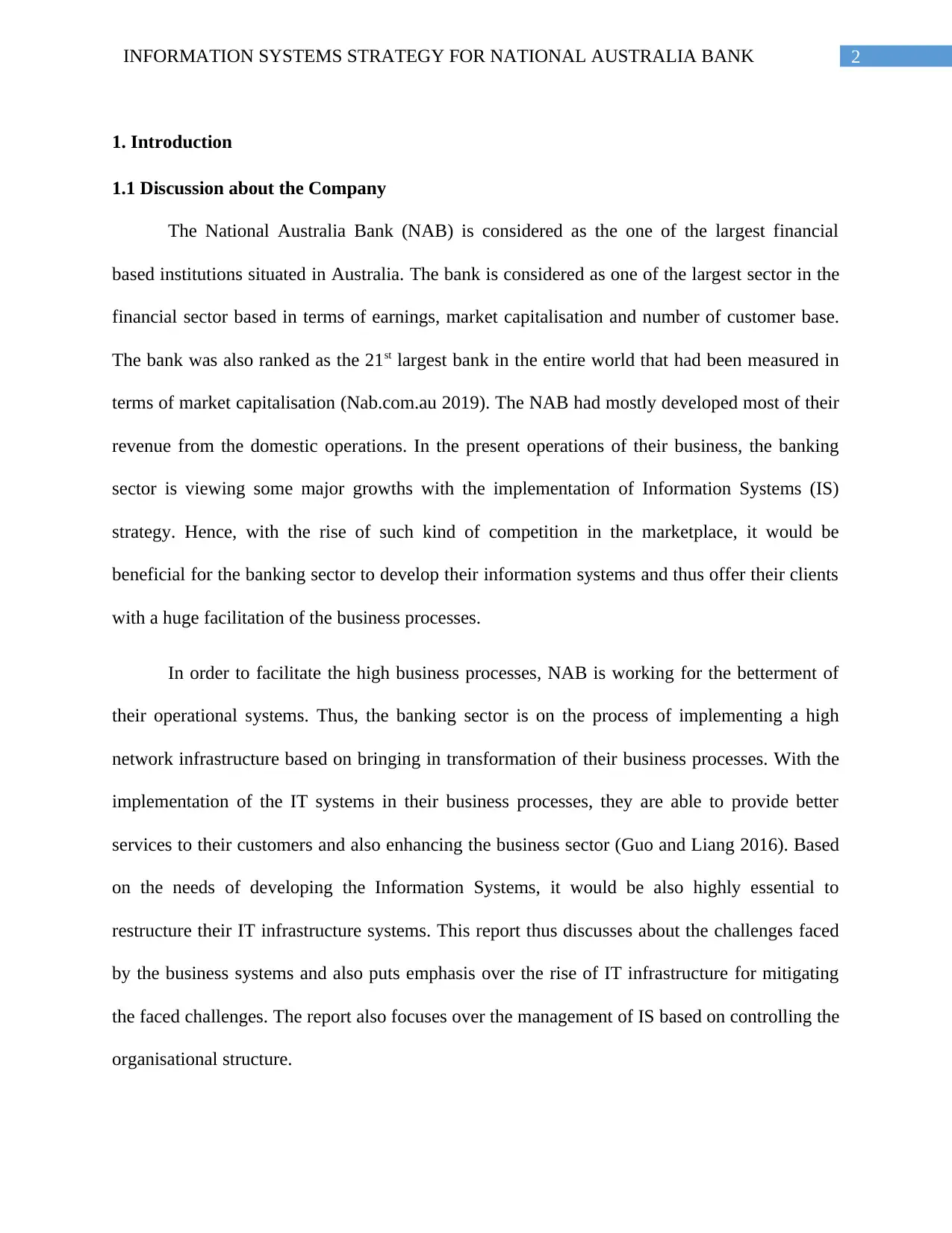
2INFORMATION SYSTEMS STRATEGY FOR NATIONAL AUSTRALIA BANK
1. Introduction
1.1 Discussion about the Company
The National Australia Bank (NAB) is considered as the one of the largest financial
based institutions situated in Australia. The bank is considered as one of the largest sector in the
financial sector based in terms of earnings, market capitalisation and number of customer base.
The bank was also ranked as the 21st largest bank in the entire world that had been measured in
terms of market capitalisation (Nab.com.au 2019). The NAB had mostly developed most of their
revenue from the domestic operations. In the present operations of their business, the banking
sector is viewing some major growths with the implementation of Information Systems (IS)
strategy. Hence, with the rise of such kind of competition in the marketplace, it would be
beneficial for the banking sector to develop their information systems and thus offer their clients
with a huge facilitation of the business processes.
In order to facilitate the high business processes, NAB is working for the betterment of
their operational systems. Thus, the banking sector is on the process of implementing a high
network infrastructure based on bringing in transformation of their business processes. With the
implementation of the IT systems in their business processes, they are able to provide better
services to their customers and also enhancing the business sector (Guo and Liang 2016). Based
on the needs of developing the Information Systems, it would be also highly essential to
restructure their IT infrastructure systems. This report thus discusses about the challenges faced
by the business systems and also puts emphasis over the rise of IT infrastructure for mitigating
the faced challenges. The report also focuses over the management of IS based on controlling the
organisational structure.
1. Introduction
1.1 Discussion about the Company
The National Australia Bank (NAB) is considered as the one of the largest financial
based institutions situated in Australia. The bank is considered as one of the largest sector in the
financial sector based in terms of earnings, market capitalisation and number of customer base.
The bank was also ranked as the 21st largest bank in the entire world that had been measured in
terms of market capitalisation (Nab.com.au 2019). The NAB had mostly developed most of their
revenue from the domestic operations. In the present operations of their business, the banking
sector is viewing some major growths with the implementation of Information Systems (IS)
strategy. Hence, with the rise of such kind of competition in the marketplace, it would be
beneficial for the banking sector to develop their information systems and thus offer their clients
with a huge facilitation of the business processes.
In order to facilitate the high business processes, NAB is working for the betterment of
their operational systems. Thus, the banking sector is on the process of implementing a high
network infrastructure based on bringing in transformation of their business processes. With the
implementation of the IT systems in their business processes, they are able to provide better
services to their customers and also enhancing the business sector (Guo and Liang 2016). Based
on the needs of developing the Information Systems, it would be also highly essential to
restructure their IT infrastructure systems. This report thus discusses about the challenges faced
by the business systems and also puts emphasis over the rise of IT infrastructure for mitigating
the faced challenges. The report also focuses over the management of IS based on controlling the
organisational structure.
⊘ This is a preview!⊘
Do you want full access?
Subscribe today to unlock all pages.

Trusted by 1+ million students worldwide

3INFORMATION SYSTEMS STRATEGY FOR NATIONAL AUSTRALIA BANK
Paraphrase This Document
Need a fresh take? Get an instant paraphrase of this document with our AI Paraphraser
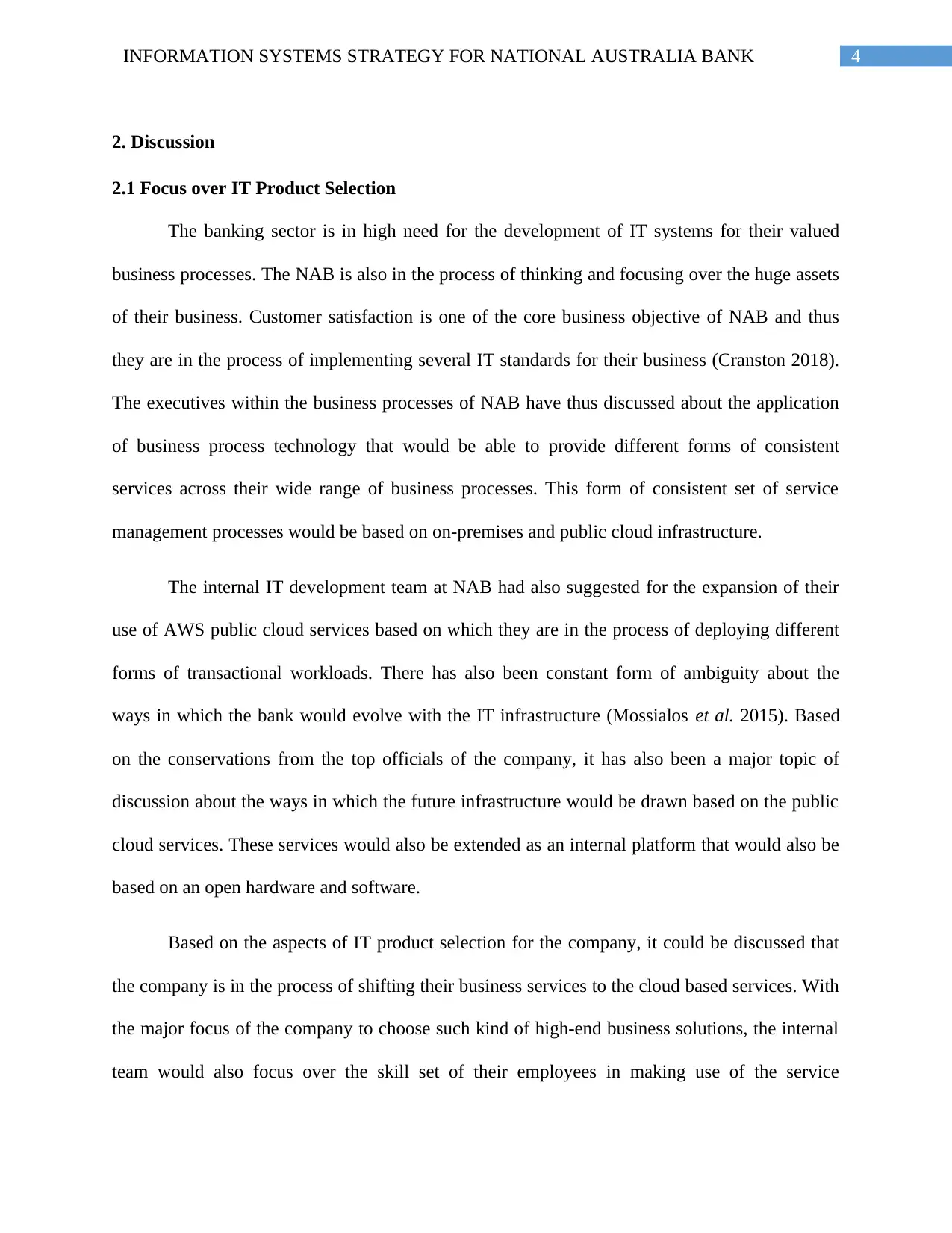
4INFORMATION SYSTEMS STRATEGY FOR NATIONAL AUSTRALIA BANK
2. Discussion
2.1 Focus over IT Product Selection
The banking sector is in high need for the development of IT systems for their valued
business processes. The NAB is also in the process of thinking and focusing over the huge assets
of their business. Customer satisfaction is one of the core business objective of NAB and thus
they are in the process of implementing several IT standards for their business (Cranston 2018).
The executives within the business processes of NAB have thus discussed about the application
of business process technology that would be able to provide different forms of consistent
services across their wide range of business processes. This form of consistent set of service
management processes would be based on on-premises and public cloud infrastructure.
The internal IT development team at NAB had also suggested for the expansion of their
use of AWS public cloud services based on which they are in the process of deploying different
forms of transactional workloads. There has also been constant form of ambiguity about the
ways in which the bank would evolve with the IT infrastructure (Mossialos et al. 2015). Based
on the conservations from the top officials of the company, it has also been a major topic of
discussion about the ways in which the future infrastructure would be drawn based on the public
cloud services. These services would also be extended as an internal platform that would also be
based on an open hardware and software.
Based on the aspects of IT product selection for the company, it could be discussed that
the company is in the process of shifting their business services to the cloud based services. With
the major focus of the company to choose such kind of high-end business solutions, the internal
team would also focus over the skill set of their employees in making use of the service
2. Discussion
2.1 Focus over IT Product Selection
The banking sector is in high need for the development of IT systems for their valued
business processes. The NAB is also in the process of thinking and focusing over the huge assets
of their business. Customer satisfaction is one of the core business objective of NAB and thus
they are in the process of implementing several IT standards for their business (Cranston 2018).
The executives within the business processes of NAB have thus discussed about the application
of business process technology that would be able to provide different forms of consistent
services across their wide range of business processes. This form of consistent set of service
management processes would be based on on-premises and public cloud infrastructure.
The internal IT development team at NAB had also suggested for the expansion of their
use of AWS public cloud services based on which they are in the process of deploying different
forms of transactional workloads. There has also been constant form of ambiguity about the
ways in which the bank would evolve with the IT infrastructure (Mossialos et al. 2015). Based
on the conservations from the top officials of the company, it has also been a major topic of
discussion about the ways in which the future infrastructure would be drawn based on the public
cloud services. These services would also be extended as an internal platform that would also be
based on an open hardware and software.
Based on the aspects of IT product selection for the company, it could be discussed that
the company is in the process of shifting their business services to the cloud based services. With
the major focus of the company to choose such kind of high-end business solutions, the internal
team would also focus over the skill set of their employees in making use of the service
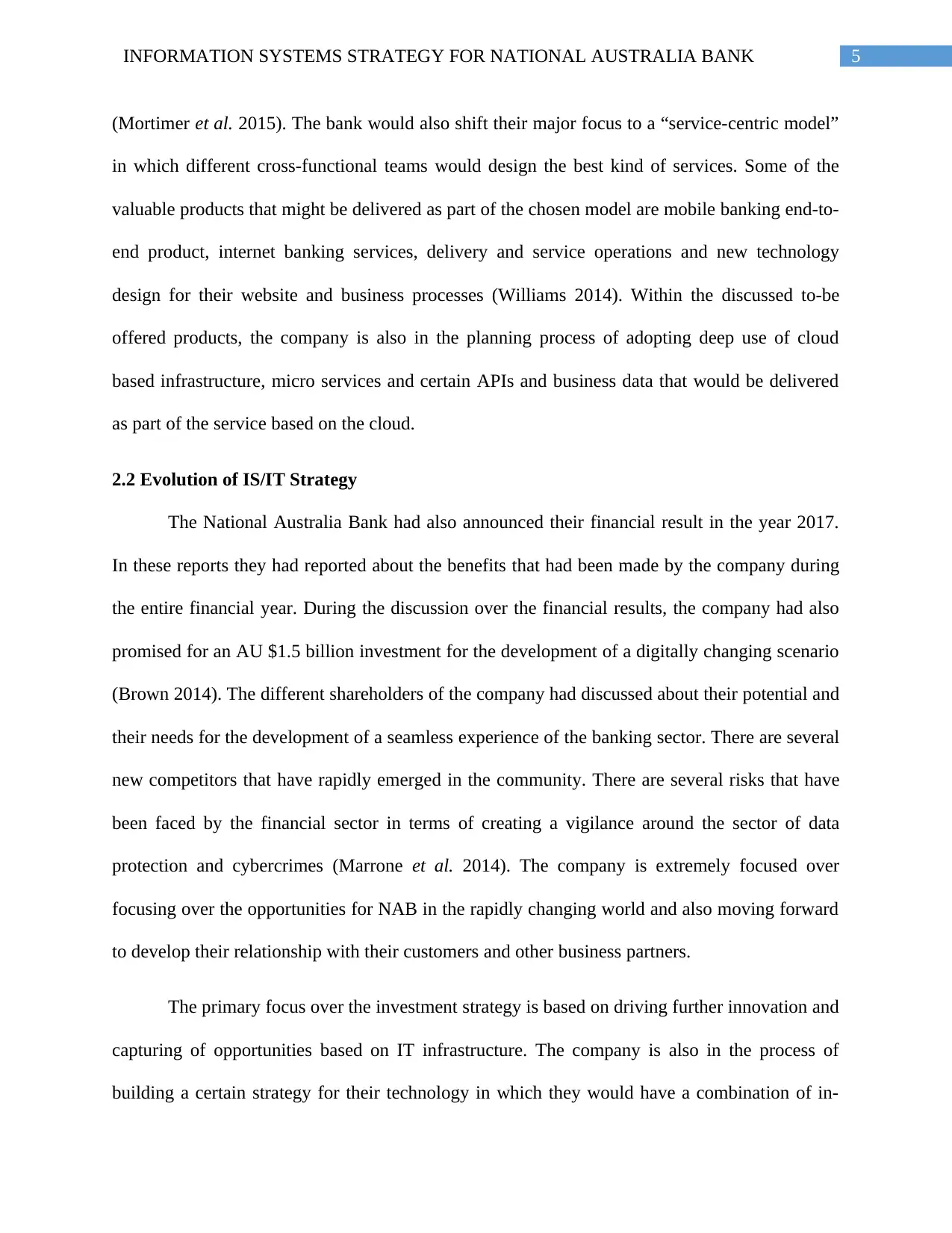
5INFORMATION SYSTEMS STRATEGY FOR NATIONAL AUSTRALIA BANK
(Mortimer et al. 2015). The bank would also shift their major focus to a “service-centric model”
in which different cross-functional teams would design the best kind of services. Some of the
valuable products that might be delivered as part of the chosen model are mobile banking end-to-
end product, internet banking services, delivery and service operations and new technology
design for their website and business processes (Williams 2014). Within the discussed to-be
offered products, the company is also in the planning process of adopting deep use of cloud
based infrastructure, micro services and certain APIs and business data that would be delivered
as part of the service based on the cloud.
2.2 Evolution of IS/IT Strategy
The National Australia Bank had also announced their financial result in the year 2017.
In these reports they had reported about the benefits that had been made by the company during
the entire financial year. During the discussion over the financial results, the company had also
promised for an AU $1.5 billion investment for the development of a digitally changing scenario
(Brown 2014). The different shareholders of the company had discussed about their potential and
their needs for the development of a seamless experience of the banking sector. There are several
new competitors that have rapidly emerged in the community. There are several risks that have
been faced by the financial sector in terms of creating a vigilance around the sector of data
protection and cybercrimes (Marrone et al. 2014). The company is extremely focused over
focusing over the opportunities for NAB in the rapidly changing world and also moving forward
to develop their relationship with their customers and other business partners.
The primary focus over the investment strategy is based on driving further innovation and
capturing of opportunities based on IT infrastructure. The company is also in the process of
building a certain strategy for their technology in which they would have a combination of in-
(Mortimer et al. 2015). The bank would also shift their major focus to a “service-centric model”
in which different cross-functional teams would design the best kind of services. Some of the
valuable products that might be delivered as part of the chosen model are mobile banking end-to-
end product, internet banking services, delivery and service operations and new technology
design for their website and business processes (Williams 2014). Within the discussed to-be
offered products, the company is also in the planning process of adopting deep use of cloud
based infrastructure, micro services and certain APIs and business data that would be delivered
as part of the service based on the cloud.
2.2 Evolution of IS/IT Strategy
The National Australia Bank had also announced their financial result in the year 2017.
In these reports they had reported about the benefits that had been made by the company during
the entire financial year. During the discussion over the financial results, the company had also
promised for an AU $1.5 billion investment for the development of a digitally changing scenario
(Brown 2014). The different shareholders of the company had discussed about their potential and
their needs for the development of a seamless experience of the banking sector. There are several
new competitors that have rapidly emerged in the community. There are several risks that have
been faced by the financial sector in terms of creating a vigilance around the sector of data
protection and cybercrimes (Marrone et al. 2014). The company is extremely focused over
focusing over the opportunities for NAB in the rapidly changing world and also moving forward
to develop their relationship with their customers and other business partners.
The primary focus over the investment strategy is based on driving further innovation and
capturing of opportunities based on IT infrastructure. The company is also in the process of
building a certain strategy for their technology in which they would have a combination of in-
⊘ This is a preview!⊘
Do you want full access?
Subscribe today to unlock all pages.

Trusted by 1+ million students worldwide
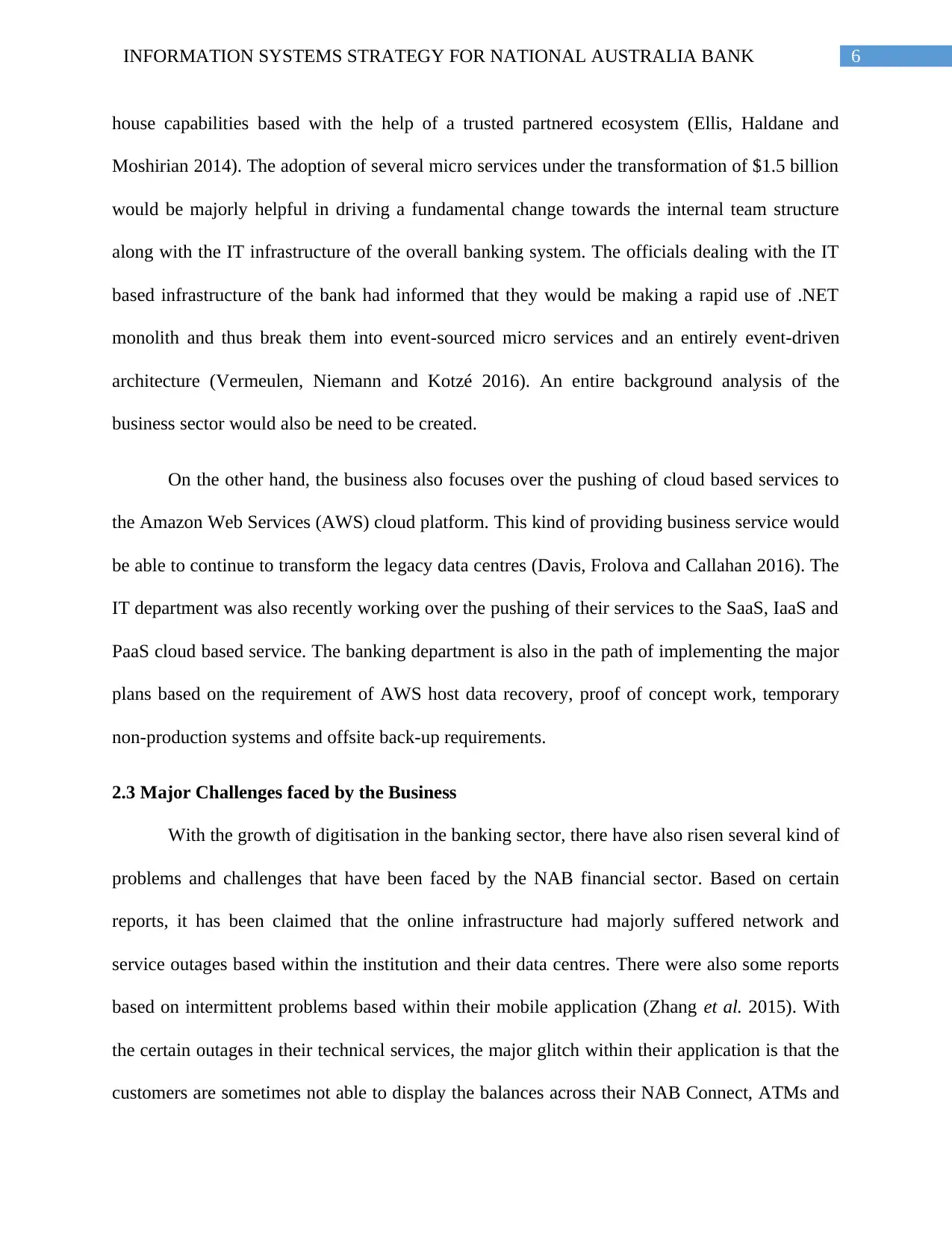
6INFORMATION SYSTEMS STRATEGY FOR NATIONAL AUSTRALIA BANK
house capabilities based with the help of a trusted partnered ecosystem (Ellis, Haldane and
Moshirian 2014). The adoption of several micro services under the transformation of $1.5 billion
would be majorly helpful in driving a fundamental change towards the internal team structure
along with the IT infrastructure of the overall banking system. The officials dealing with the IT
based infrastructure of the bank had informed that they would be making a rapid use of .NET
monolith and thus break them into event-sourced micro services and an entirely event-driven
architecture (Vermeulen, Niemann and Kotzé 2016). An entire background analysis of the
business sector would also be need to be created.
On the other hand, the business also focuses over the pushing of cloud based services to
the Amazon Web Services (AWS) cloud platform. This kind of providing business service would
be able to continue to transform the legacy data centres (Davis, Frolova and Callahan 2016). The
IT department was also recently working over the pushing of their services to the SaaS, IaaS and
PaaS cloud based service. The banking department is also in the path of implementing the major
plans based on the requirement of AWS host data recovery, proof of concept work, temporary
non-production systems and offsite back-up requirements.
2.3 Major Challenges faced by the Business
With the growth of digitisation in the banking sector, there have also risen several kind of
problems and challenges that have been faced by the NAB financial sector. Based on certain
reports, it has been claimed that the online infrastructure had majorly suffered network and
service outages based within the institution and their data centres. There were also some reports
based on intermittent problems based within their mobile application (Zhang et al. 2015). With
the certain outages in their technical services, the major glitch within their application is that the
customers are sometimes not able to display the balances across their NAB Connect, ATMs and
house capabilities based with the help of a trusted partnered ecosystem (Ellis, Haldane and
Moshirian 2014). The adoption of several micro services under the transformation of $1.5 billion
would be majorly helpful in driving a fundamental change towards the internal team structure
along with the IT infrastructure of the overall banking system. The officials dealing with the IT
based infrastructure of the bank had informed that they would be making a rapid use of .NET
monolith and thus break them into event-sourced micro services and an entirely event-driven
architecture (Vermeulen, Niemann and Kotzé 2016). An entire background analysis of the
business sector would also be need to be created.
On the other hand, the business also focuses over the pushing of cloud based services to
the Amazon Web Services (AWS) cloud platform. This kind of providing business service would
be able to continue to transform the legacy data centres (Davis, Frolova and Callahan 2016). The
IT department was also recently working over the pushing of their services to the SaaS, IaaS and
PaaS cloud based service. The banking department is also in the path of implementing the major
plans based on the requirement of AWS host data recovery, proof of concept work, temporary
non-production systems and offsite back-up requirements.
2.3 Major Challenges faced by the Business
With the growth of digitisation in the banking sector, there have also risen several kind of
problems and challenges that have been faced by the NAB financial sector. Based on certain
reports, it has been claimed that the online infrastructure had majorly suffered network and
service outages based within the institution and their data centres. There were also some reports
based on intermittent problems based within their mobile application (Zhang et al. 2015). With
the certain outages in their technical services, the major glitch within their application is that the
customers are sometimes not able to display the balances across their NAB Connect, ATMs and
Paraphrase This Document
Need a fresh take? Get an instant paraphrase of this document with our AI Paraphraser
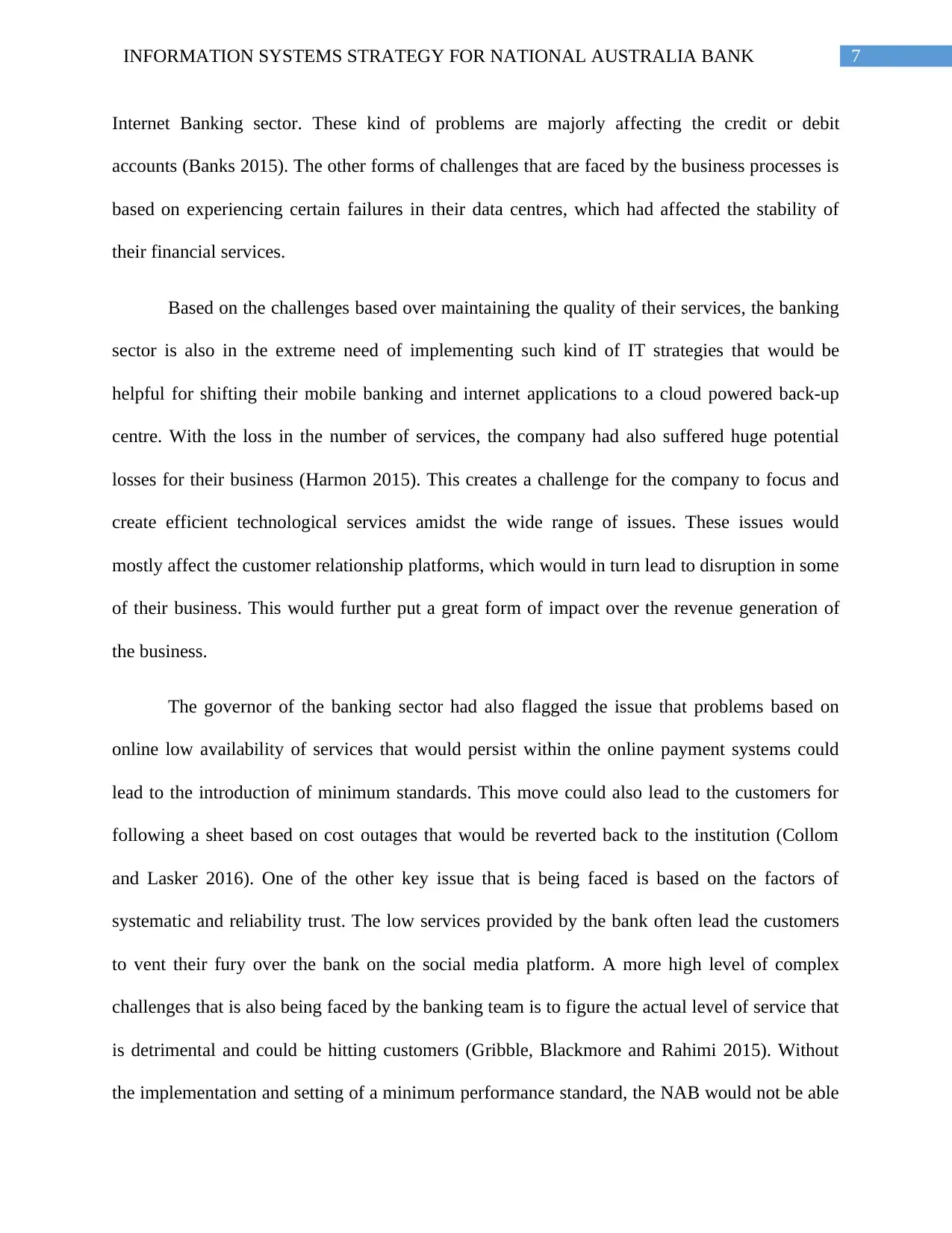
7INFORMATION SYSTEMS STRATEGY FOR NATIONAL AUSTRALIA BANK
Internet Banking sector. These kind of problems are majorly affecting the credit or debit
accounts (Banks 2015). The other forms of challenges that are faced by the business processes is
based on experiencing certain failures in their data centres, which had affected the stability of
their financial services.
Based on the challenges based over maintaining the quality of their services, the banking
sector is also in the extreme need of implementing such kind of IT strategies that would be
helpful for shifting their mobile banking and internet applications to a cloud powered back-up
centre. With the loss in the number of services, the company had also suffered huge potential
losses for their business (Harmon 2015). This creates a challenge for the company to focus and
create efficient technological services amidst the wide range of issues. These issues would
mostly affect the customer relationship platforms, which would in turn lead to disruption in some
of their business. This would further put a great form of impact over the revenue generation of
the business.
The governor of the banking sector had also flagged the issue that problems based on
online low availability of services that would persist within the online payment systems could
lead to the introduction of minimum standards. This move could also lead to the customers for
following a sheet based on cost outages that would be reverted back to the institution (Collom
and Lasker 2016). One of the other key issue that is being faced is based on the factors of
systematic and reliability trust. The low services provided by the bank often lead the customers
to vent their fury over the bank on the social media platform. A more high level of complex
challenges that is also being faced by the banking team is to figure the actual level of service that
is detrimental and could be hitting customers (Gribble, Blackmore and Rahimi 2015). Without
the implementation and setting of a minimum performance standard, the NAB would not be able
Internet Banking sector. These kind of problems are majorly affecting the credit or debit
accounts (Banks 2015). The other forms of challenges that are faced by the business processes is
based on experiencing certain failures in their data centres, which had affected the stability of
their financial services.
Based on the challenges based over maintaining the quality of their services, the banking
sector is also in the extreme need of implementing such kind of IT strategies that would be
helpful for shifting their mobile banking and internet applications to a cloud powered back-up
centre. With the loss in the number of services, the company had also suffered huge potential
losses for their business (Harmon 2015). This creates a challenge for the company to focus and
create efficient technological services amidst the wide range of issues. These issues would
mostly affect the customer relationship platforms, which would in turn lead to disruption in some
of their business. This would further put a great form of impact over the revenue generation of
the business.
The governor of the banking sector had also flagged the issue that problems based on
online low availability of services that would persist within the online payment systems could
lead to the introduction of minimum standards. This move could also lead to the customers for
following a sheet based on cost outages that would be reverted back to the institution (Collom
and Lasker 2016). One of the other key issue that is being faced is based on the factors of
systematic and reliability trust. The low services provided by the bank often lead the customers
to vent their fury over the bank on the social media platform. A more high level of complex
challenges that is also being faced by the banking team is to figure the actual level of service that
is detrimental and could be hitting customers (Gribble, Blackmore and Rahimi 2015). Without
the implementation and setting of a minimum performance standard, the NAB would not be able
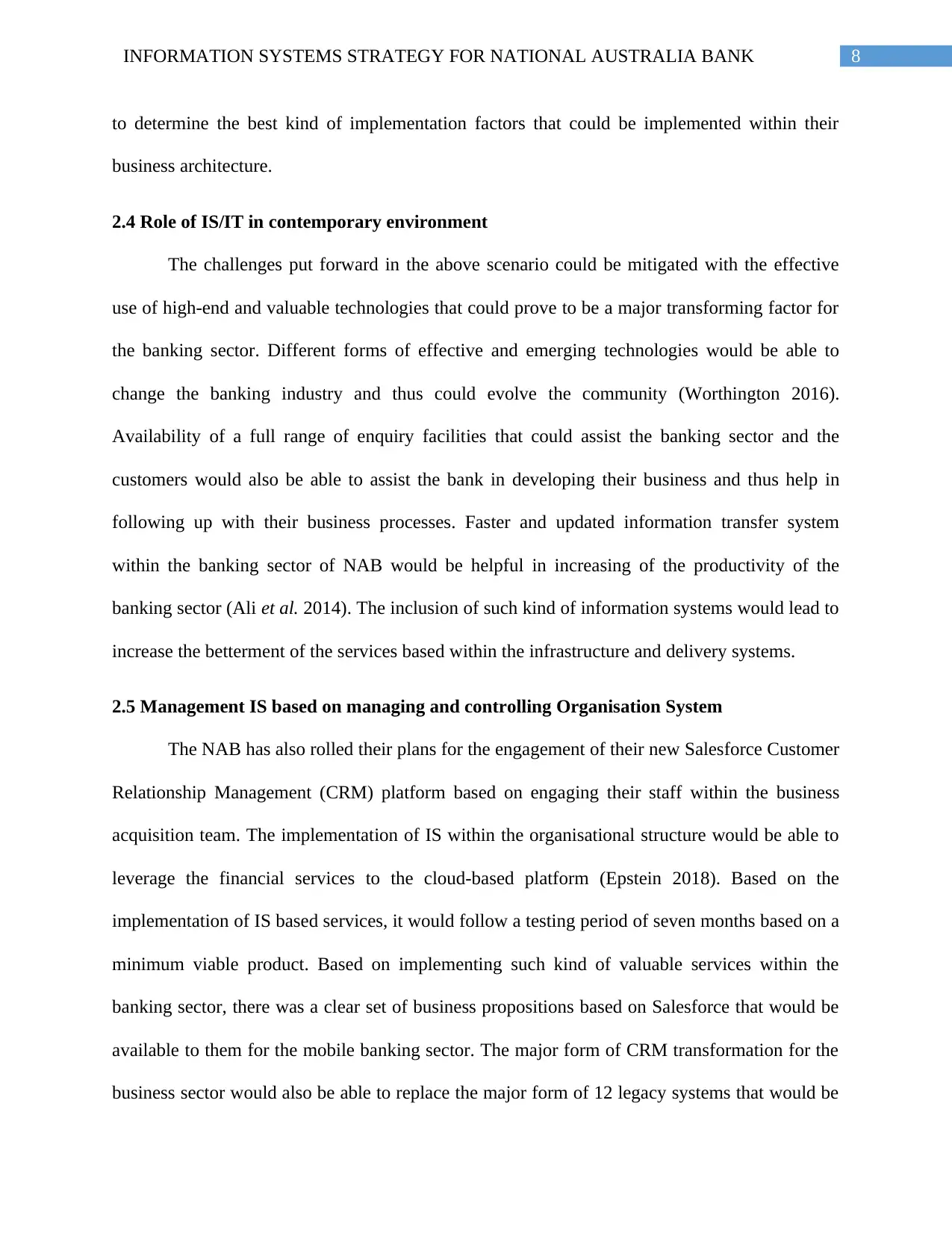
8INFORMATION SYSTEMS STRATEGY FOR NATIONAL AUSTRALIA BANK
to determine the best kind of implementation factors that could be implemented within their
business architecture.
2.4 Role of IS/IT in contemporary environment
The challenges put forward in the above scenario could be mitigated with the effective
use of high-end and valuable technologies that could prove to be a major transforming factor for
the banking sector. Different forms of effective and emerging technologies would be able to
change the banking industry and thus could evolve the community (Worthington 2016).
Availability of a full range of enquiry facilities that could assist the banking sector and the
customers would also be able to assist the bank in developing their business and thus help in
following up with their business processes. Faster and updated information transfer system
within the banking sector of NAB would be helpful in increasing of the productivity of the
banking sector (Ali et al. 2014). The inclusion of such kind of information systems would lead to
increase the betterment of the services based within the infrastructure and delivery systems.
2.5 Management IS based on managing and controlling Organisation System
The NAB has also rolled their plans for the engagement of their new Salesforce Customer
Relationship Management (CRM) platform based on engaging their staff within the business
acquisition team. The implementation of IS within the organisational structure would be able to
leverage the financial services to the cloud-based platform (Epstein 2018). Based on the
implementation of IS based services, it would follow a testing period of seven months based on a
minimum viable product. Based on implementing such kind of valuable services within the
banking sector, there was a clear set of business propositions based on Salesforce that would be
available to them for the mobile banking sector. The major form of CRM transformation for the
business sector would also be able to replace the major form of 12 legacy systems that would be
to determine the best kind of implementation factors that could be implemented within their
business architecture.
2.4 Role of IS/IT in contemporary environment
The challenges put forward in the above scenario could be mitigated with the effective
use of high-end and valuable technologies that could prove to be a major transforming factor for
the banking sector. Different forms of effective and emerging technologies would be able to
change the banking industry and thus could evolve the community (Worthington 2016).
Availability of a full range of enquiry facilities that could assist the banking sector and the
customers would also be able to assist the bank in developing their business and thus help in
following up with their business processes. Faster and updated information transfer system
within the banking sector of NAB would be helpful in increasing of the productivity of the
banking sector (Ali et al. 2014). The inclusion of such kind of information systems would lead to
increase the betterment of the services based within the infrastructure and delivery systems.
2.5 Management IS based on managing and controlling Organisation System
The NAB has also rolled their plans for the engagement of their new Salesforce Customer
Relationship Management (CRM) platform based on engaging their staff within the business
acquisition team. The implementation of IS within the organisational structure would be able to
leverage the financial services to the cloud-based platform (Epstein 2018). Based on the
implementation of IS based services, it would follow a testing period of seven months based on a
minimum viable product. Based on implementing such kind of valuable services within the
banking sector, there was a clear set of business propositions based on Salesforce that would be
available to them for the mobile banking sector. The major form of CRM transformation for the
business sector would also be able to replace the major form of 12 legacy systems that would be
⊘ This is a preview!⊘
Do you want full access?
Subscribe today to unlock all pages.

Trusted by 1+ million students worldwide
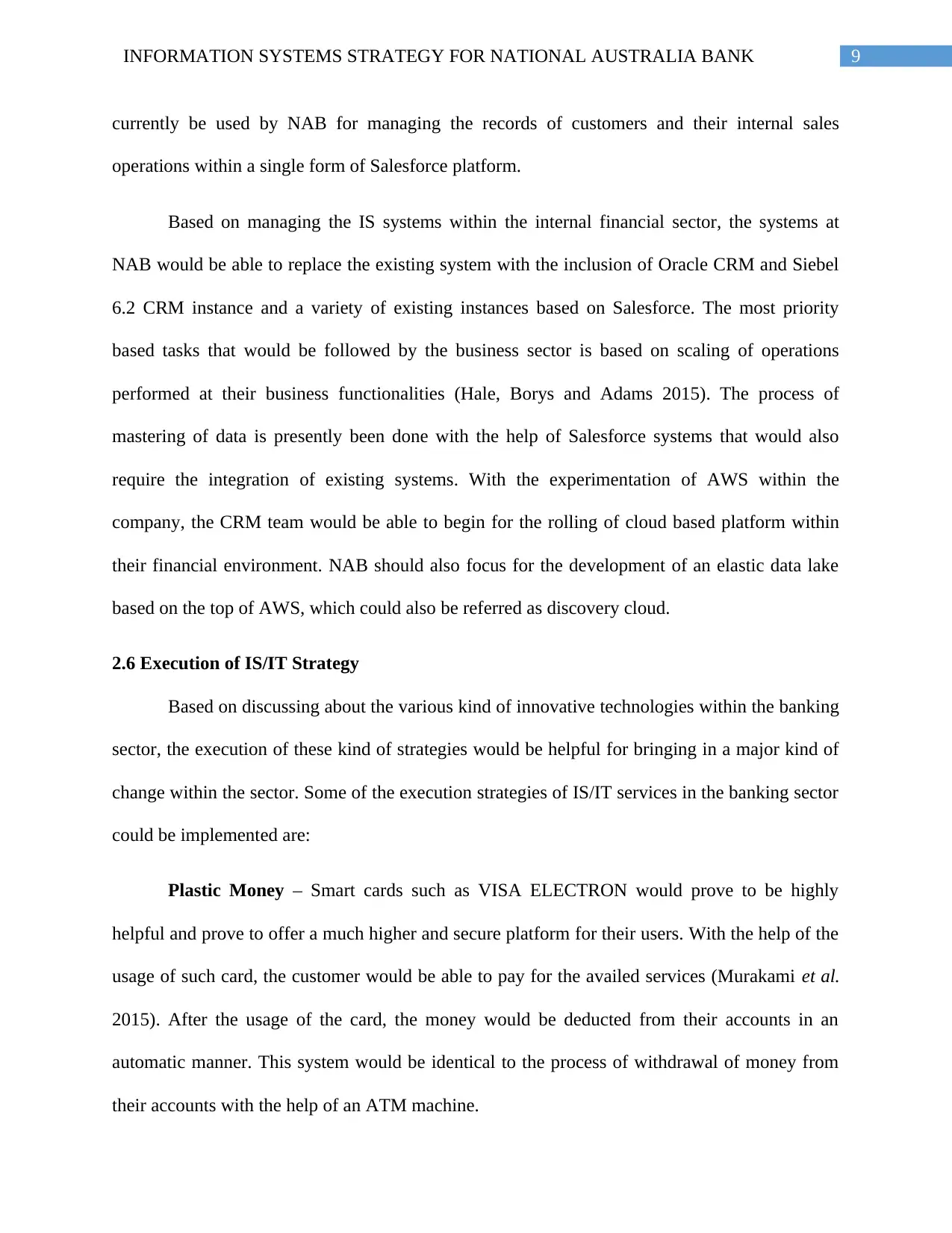
9INFORMATION SYSTEMS STRATEGY FOR NATIONAL AUSTRALIA BANK
currently be used by NAB for managing the records of customers and their internal sales
operations within a single form of Salesforce platform.
Based on managing the IS systems within the internal financial sector, the systems at
NAB would be able to replace the existing system with the inclusion of Oracle CRM and Siebel
6.2 CRM instance and a variety of existing instances based on Salesforce. The most priority
based tasks that would be followed by the business sector is based on scaling of operations
performed at their business functionalities (Hale, Borys and Adams 2015). The process of
mastering of data is presently been done with the help of Salesforce systems that would also
require the integration of existing systems. With the experimentation of AWS within the
company, the CRM team would be able to begin for the rolling of cloud based platform within
their financial environment. NAB should also focus for the development of an elastic data lake
based on the top of AWS, which could also be referred as discovery cloud.
2.6 Execution of IS/IT Strategy
Based on discussing about the various kind of innovative technologies within the banking
sector, the execution of these kind of strategies would be helpful for bringing in a major kind of
change within the sector. Some of the execution strategies of IS/IT services in the banking sector
could be implemented are:
Plastic Money – Smart cards such as VISA ELECTRON would prove to be highly
helpful and prove to offer a much higher and secure platform for their users. With the help of the
usage of such card, the customer would be able to pay for the availed services (Murakami et al.
2015). After the usage of the card, the money would be deducted from their accounts in an
automatic manner. This system would be identical to the process of withdrawal of money from
their accounts with the help of an ATM machine.
currently be used by NAB for managing the records of customers and their internal sales
operations within a single form of Salesforce platform.
Based on managing the IS systems within the internal financial sector, the systems at
NAB would be able to replace the existing system with the inclusion of Oracle CRM and Siebel
6.2 CRM instance and a variety of existing instances based on Salesforce. The most priority
based tasks that would be followed by the business sector is based on scaling of operations
performed at their business functionalities (Hale, Borys and Adams 2015). The process of
mastering of data is presently been done with the help of Salesforce systems that would also
require the integration of existing systems. With the experimentation of AWS within the
company, the CRM team would be able to begin for the rolling of cloud based platform within
their financial environment. NAB should also focus for the development of an elastic data lake
based on the top of AWS, which could also be referred as discovery cloud.
2.6 Execution of IS/IT Strategy
Based on discussing about the various kind of innovative technologies within the banking
sector, the execution of these kind of strategies would be helpful for bringing in a major kind of
change within the sector. Some of the execution strategies of IS/IT services in the banking sector
could be implemented are:
Plastic Money – Smart cards such as VISA ELECTRON would prove to be highly
helpful and prove to offer a much higher and secure platform for their users. With the help of the
usage of such card, the customer would be able to pay for the availed services (Murakami et al.
2015). After the usage of the card, the money would be deducted from their accounts in an
automatic manner. This system would be identical to the process of withdrawal of money from
their accounts with the help of an ATM machine.
Paraphrase This Document
Need a fresh take? Get an instant paraphrase of this document with our AI Paraphraser
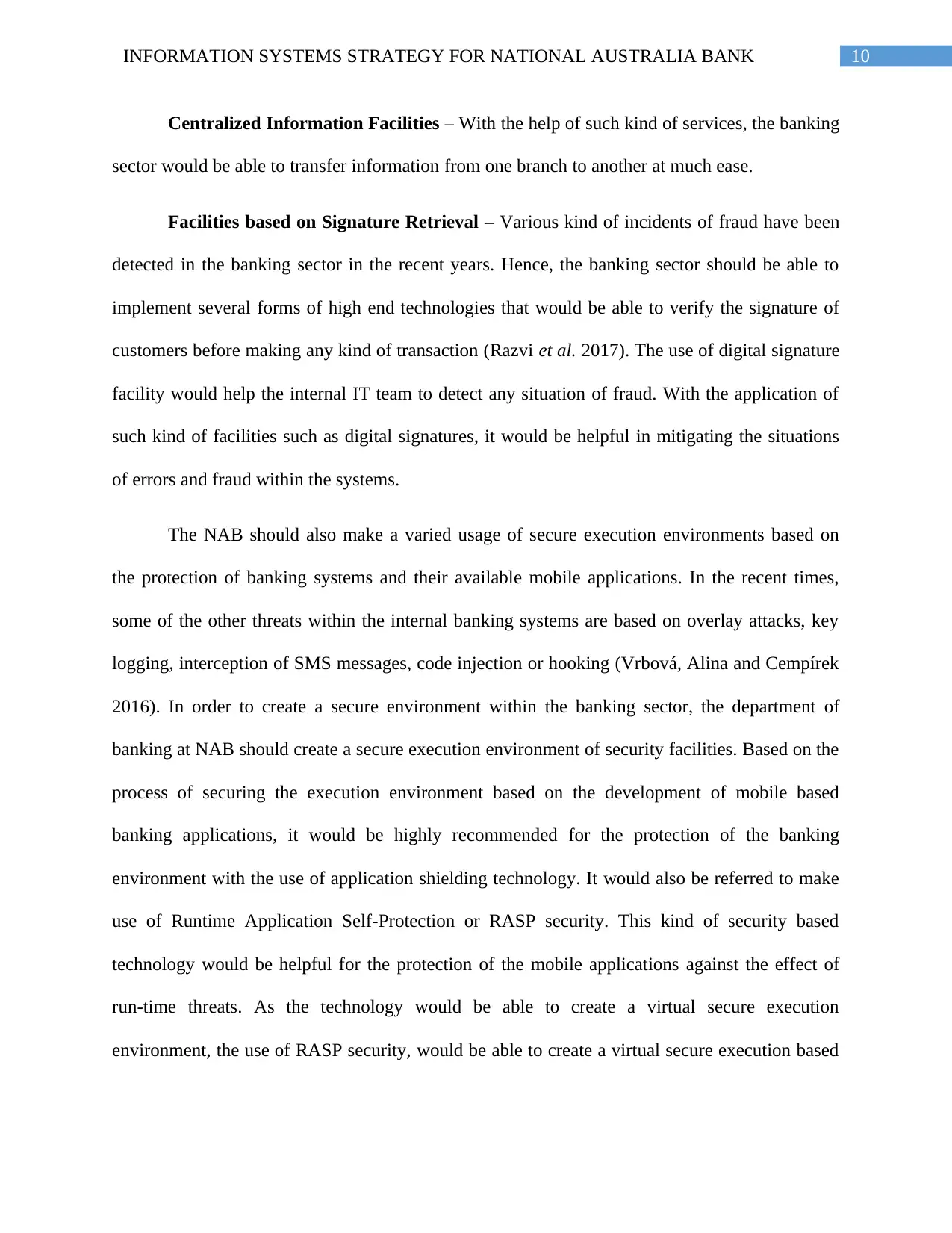
10INFORMATION SYSTEMS STRATEGY FOR NATIONAL AUSTRALIA BANK
Centralized Information Facilities – With the help of such kind of services, the banking
sector would be able to transfer information from one branch to another at much ease.
Facilities based on Signature Retrieval – Various kind of incidents of fraud have been
detected in the banking sector in the recent years. Hence, the banking sector should be able to
implement several forms of high end technologies that would be able to verify the signature of
customers before making any kind of transaction (Razvi et al. 2017). The use of digital signature
facility would help the internal IT team to detect any situation of fraud. With the application of
such kind of facilities such as digital signatures, it would be helpful in mitigating the situations
of errors and fraud within the systems.
The NAB should also make a varied usage of secure execution environments based on
the protection of banking systems and their available mobile applications. In the recent times,
some of the other threats within the internal banking systems are based on overlay attacks, key
logging, interception of SMS messages, code injection or hooking (Vrbová, Alina and Cempírek
2016). In order to create a secure environment within the banking sector, the department of
banking at NAB should create a secure execution environment of security facilities. Based on the
process of securing the execution environment based on the development of mobile based
banking applications, it would be highly recommended for the protection of the banking
environment with the use of application shielding technology. It would also be referred to make
use of Runtime Application Self-Protection or RASP security. This kind of security based
technology would be helpful for the protection of the mobile applications against the effect of
run-time threats. As the technology would be able to create a virtual secure execution
environment, the use of RASP security, would be able to create a virtual secure execution based
Centralized Information Facilities – With the help of such kind of services, the banking
sector would be able to transfer information from one branch to another at much ease.
Facilities based on Signature Retrieval – Various kind of incidents of fraud have been
detected in the banking sector in the recent years. Hence, the banking sector should be able to
implement several forms of high end technologies that would be able to verify the signature of
customers before making any kind of transaction (Razvi et al. 2017). The use of digital signature
facility would help the internal IT team to detect any situation of fraud. With the application of
such kind of facilities such as digital signatures, it would be helpful in mitigating the situations
of errors and fraud within the systems.
The NAB should also make a varied usage of secure execution environments based on
the protection of banking systems and their available mobile applications. In the recent times,
some of the other threats within the internal banking systems are based on overlay attacks, key
logging, interception of SMS messages, code injection or hooking (Vrbová, Alina and Cempírek
2016). In order to create a secure environment within the banking sector, the department of
banking at NAB should create a secure execution environment of security facilities. Based on the
process of securing the execution environment based on the development of mobile based
banking applications, it would be highly recommended for the protection of the banking
environment with the use of application shielding technology. It would also be referred to make
use of Runtime Application Self-Protection or RASP security. This kind of security based
technology would be helpful for the protection of the mobile applications against the effect of
run-time threats. As the technology would be able to create a virtual secure execution
environment, the use of RASP security, would be able to create a virtual secure execution based
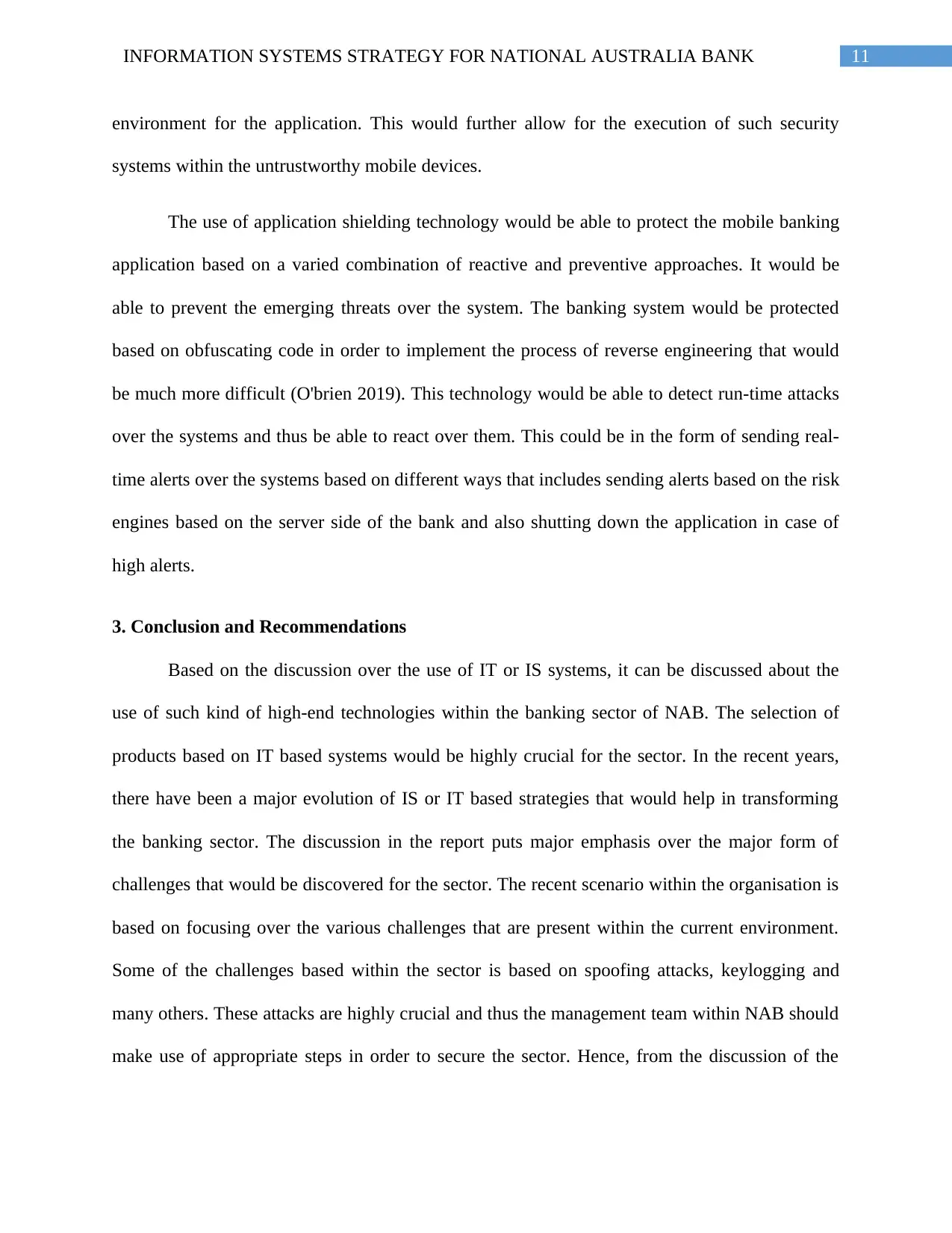
11INFORMATION SYSTEMS STRATEGY FOR NATIONAL AUSTRALIA BANK
environment for the application. This would further allow for the execution of such security
systems within the untrustworthy mobile devices.
The use of application shielding technology would be able to protect the mobile banking
application based on a varied combination of reactive and preventive approaches. It would be
able to prevent the emerging threats over the system. The banking system would be protected
based on obfuscating code in order to implement the process of reverse engineering that would
be much more difficult (O'brien 2019). This technology would be able to detect run-time attacks
over the systems and thus be able to react over them. This could be in the form of sending real-
time alerts over the systems based on different ways that includes sending alerts based on the risk
engines based on the server side of the bank and also shutting down the application in case of
high alerts.
3. Conclusion and Recommendations
Based on the discussion over the use of IT or IS systems, it can be discussed about the
use of such kind of high-end technologies within the banking sector of NAB. The selection of
products based on IT based systems would be highly crucial for the sector. In the recent years,
there have been a major evolution of IS or IT based strategies that would help in transforming
the banking sector. The discussion in the report puts major emphasis over the major form of
challenges that would be discovered for the sector. The recent scenario within the organisation is
based on focusing over the various challenges that are present within the current environment.
Some of the challenges based within the sector is based on spoofing attacks, keylogging and
many others. These attacks are highly crucial and thus the management team within NAB should
make use of appropriate steps in order to secure the sector. Hence, from the discussion of the
environment for the application. This would further allow for the execution of such security
systems within the untrustworthy mobile devices.
The use of application shielding technology would be able to protect the mobile banking
application based on a varied combination of reactive and preventive approaches. It would be
able to prevent the emerging threats over the system. The banking system would be protected
based on obfuscating code in order to implement the process of reverse engineering that would
be much more difficult (O'brien 2019). This technology would be able to detect run-time attacks
over the systems and thus be able to react over them. This could be in the form of sending real-
time alerts over the systems based on different ways that includes sending alerts based on the risk
engines based on the server side of the bank and also shutting down the application in case of
high alerts.
3. Conclusion and Recommendations
Based on the discussion over the use of IT or IS systems, it can be discussed about the
use of such kind of high-end technologies within the banking sector of NAB. The selection of
products based on IT based systems would be highly crucial for the sector. In the recent years,
there have been a major evolution of IS or IT based strategies that would help in transforming
the banking sector. The discussion in the report puts major emphasis over the major form of
challenges that would be discovered for the sector. The recent scenario within the organisation is
based on focusing over the various challenges that are present within the current environment.
Some of the challenges based within the sector is based on spoofing attacks, keylogging and
many others. These attacks are highly crucial and thus the management team within NAB should
make use of appropriate steps in order to secure the sector. Hence, from the discussion of the
⊘ This is a preview!⊘
Do you want full access?
Subscribe today to unlock all pages.

Trusted by 1+ million students worldwide
1 out of 16
Related Documents
Your All-in-One AI-Powered Toolkit for Academic Success.
+13062052269
info@desklib.com
Available 24*7 on WhatsApp / Email
![[object Object]](/_next/static/media/star-bottom.7253800d.svg)
Unlock your academic potential
Copyright © 2020–2025 A2Z Services. All Rights Reserved. Developed and managed by ZUCOL.




